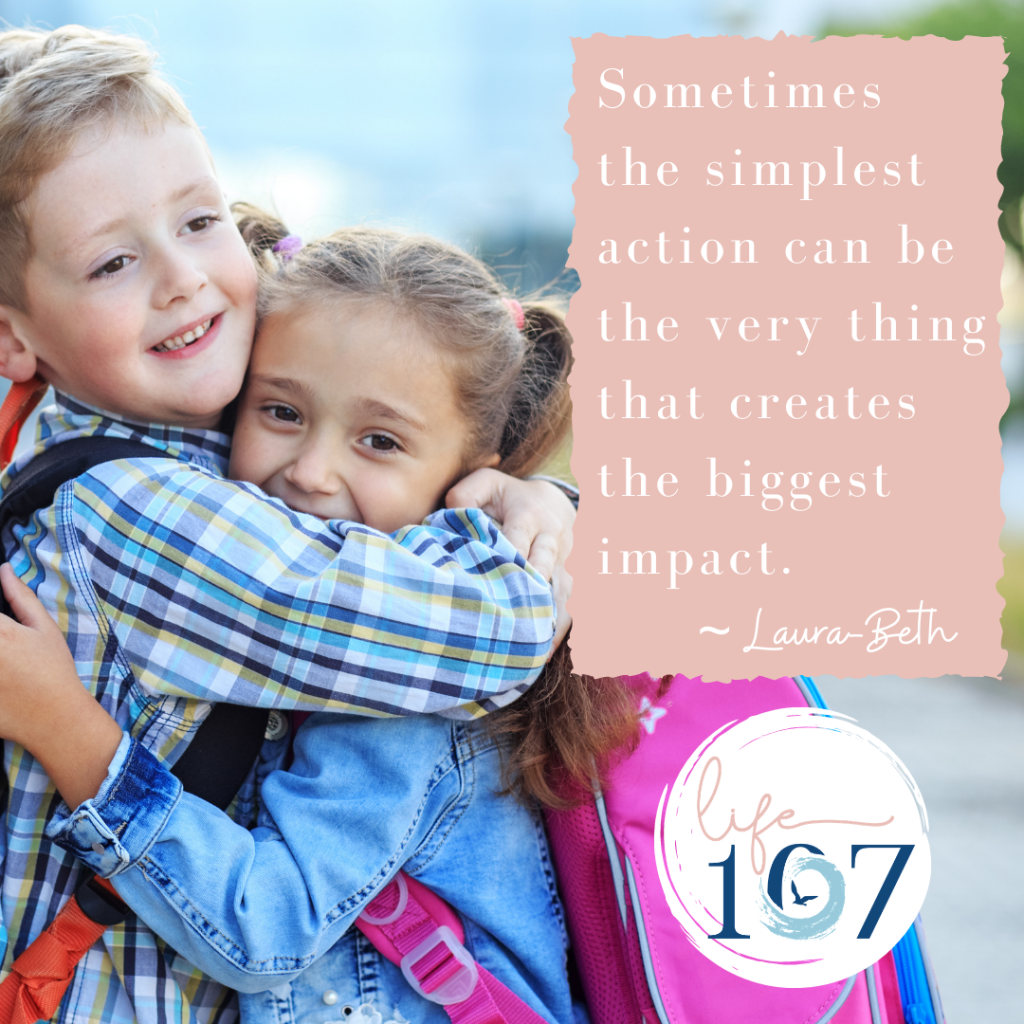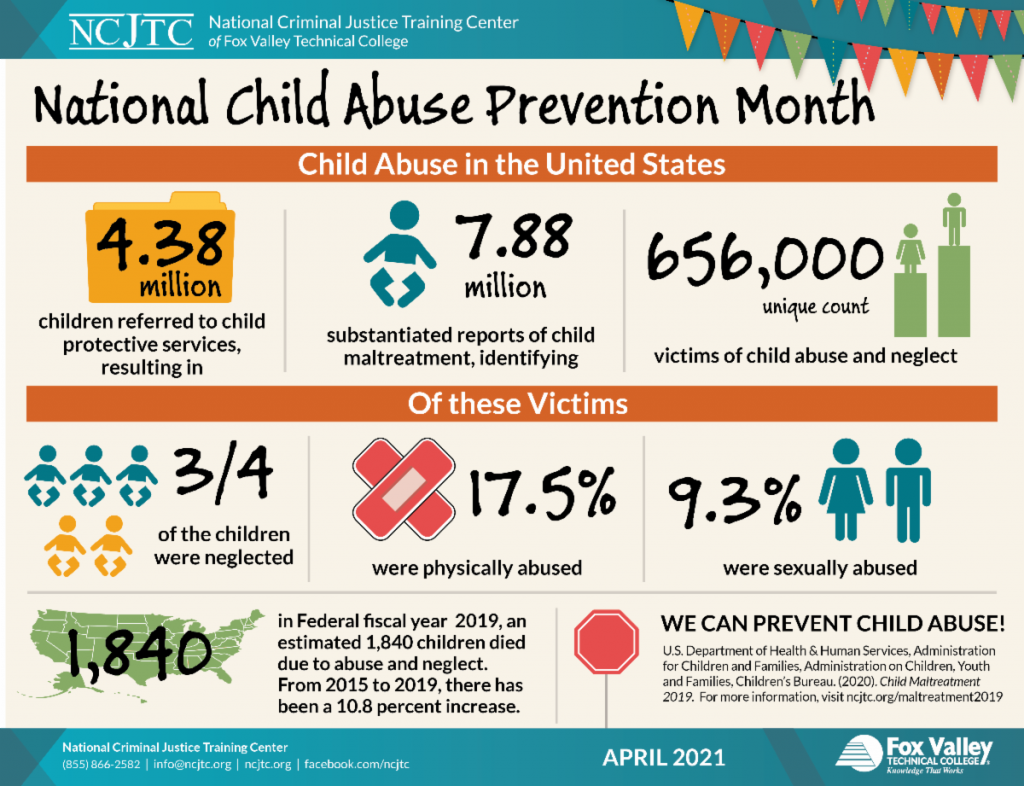Words of Life Blog
Pathways Into Panama
Written by: Joe Farris, MAHDL
Life 107 Board Member & Dropping the Stones Leader [WNCFreedom.org]
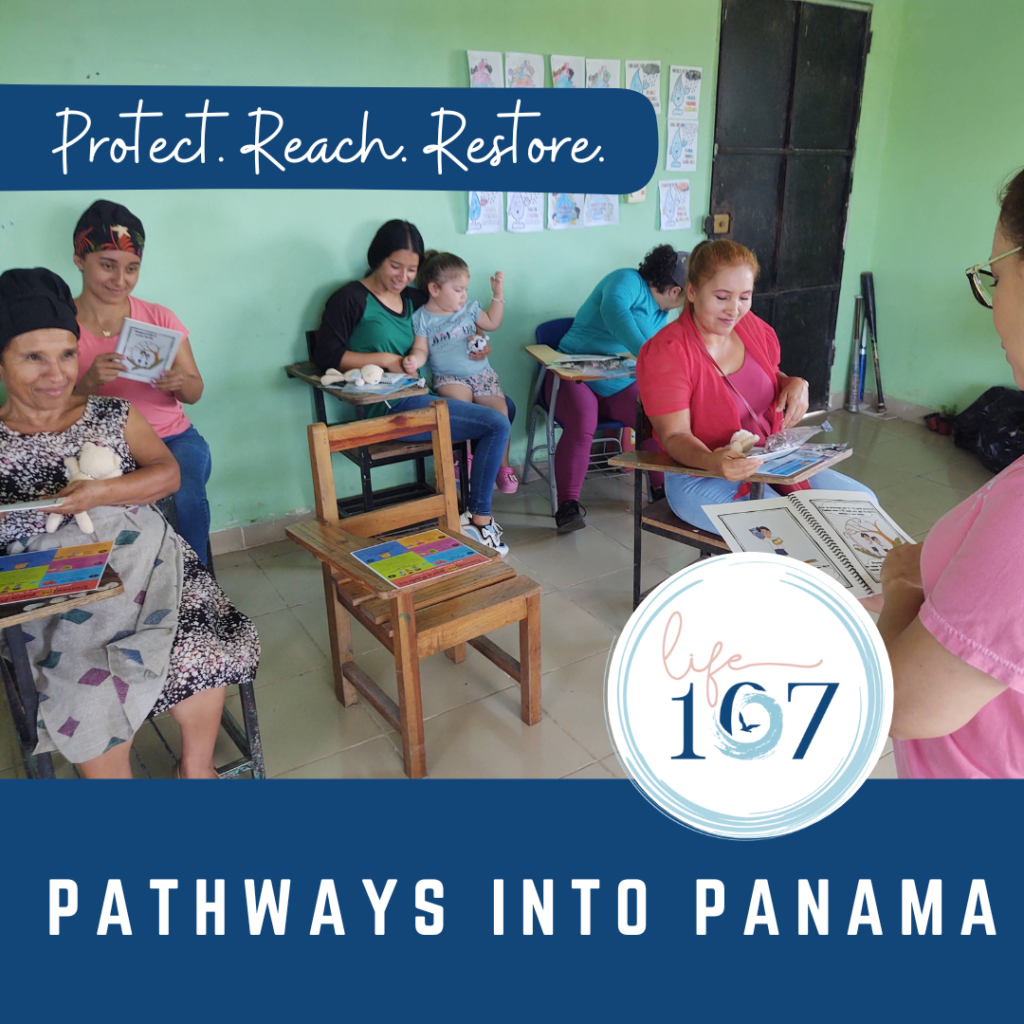
“For those of you who do not believe that God exists, this is proof!” These words, spoken in Spanish, echoed off the empty walls of a home with no beds to sleep on and no chairs to sit in. It was occupied by fourteen Venezuelan refugees struggling to make it in a foreign land. An older gentleman within this group of refugees reminded those questioning God’s presence during their foreboding circumstances, that our team was proof that God did show up. Indeed, God certainly led us to this group, and this was one of several instances that I felt as if we were walking on holy ground during our eight-day trip in Panama. On this particular day, we planned to deliver the food we purchased at a local store to this group of refugees; however, once we sat with them and saw the absence of necessities that most of us take for granted, we traveled back to the store to buy them some much-needed household items and more food. Incredibly, Christin, one of our team members, was so heartbroken by their living situation that she emptied most of the clothes from her luggage and donated them to the women. Most notably, aside from the food and necessities we left them, our presence with them lifted their spirits. No one had visited them in over eight months, and they felt nobody saw them nor cared about their plight.
Our time with the refugees was our last day of the trip, but the journey to Panama began long before we arrived. So much behind-the-scenes work went into this trip to create pathways for Life 107 to protect, reach, and restore in Panama. Yes, we wanted this trip to prevent human trafficking, one of the fundamental pillars of Life 107, but we also wanted to go deeper into the root causes while empowering women and children. Because of the patriarchal social structure within the indigenous group we planned to serve there, I knew gender-based violence (GBV) fueled the power imbalance and oppression that is fundamental to human trafficking. Indeed, at the core of human trafficking, the abuse of power is found – the basis of GBV. Therefore, I created a lesson plan on GBV for teachers, pastors, and anyone who works closely with youth to use as a preventative measure, to begin our long-term goal of turning the tide on the behaviors, traditions, and beliefs that undergird GBV within a region, community, and household.
With this in mind, the leadership at Manos de Fe, the Panamanian hosting organization, allowed me to present the lesson on GBV to their staff and once to parents and teachers at a local school. According to the co-founder of Manos de Fe, Julie, we were the first visiting team to address GBV in their community.
Manos de Fe is a Christian NGO that offers humanitarian aid through housing teen girls transitioning from orphanages or who have been mistreated, and functions a preschool, community school, and church. Manos de Fe has built relationships in northern Panama for many years, so we felt honored by the opportunity to partner with them.
Life 107 Executive Director, Demetria, and I created tip sheets for parents and teachers to protect minors from abuse and trafficking. Demetria also developed bears with biblically-based coping skills on their collars for children who have experienced traumatic events – in essence, to reduce the vulnerabilities of children to trafficking victimization and exploitation. I was able to distribute these bears to the children who live at Manos de Fe and to the school we visited, as well as disseminate tip sheets to the parents and teachers who attended the presentations on GBV. A big thanks to our translators, Nina, Brenda and Ivana, who prepared these for use among Spanish speaking populations and Brenda for adding (by the Spirit) a line to our teddy bear poem.
At the same time, I delivered copies of a children’s book in Panama that educates children on how to avoid human trafficking predators, written by Bren, CEO of Legacy of Hope International. The book has contact numbers for local agencies that can help children if they or someone they know are in danger. Copies of the book were left at the school and with the refugees we visited. Nina, the on-site director at Manos de Fe, translated the book into Spanish, and also sent copies of the book to Panama City.
Beyond the L7 initiatives to protect vulnerable children and women, we were supported by Manos de Fe to meet other needs during this mission. Ultimately, eight of us traveled to northern Panama to serve. Our compassionate team was busy each day following the Spirit’s guidance. When we visited the school, we arrived with a piñata, toys, and games for the students. Since it was Easter week, the students were in good spirits and enjoyed dancing, making crafts (such as slime), and feeling the love of our team. We visited an impoverished neighborhood in Volcán, handing out bags of groceries and praying with families. We also delivered a refrigerator to a vulnerable elderly lady whose home was half-eaten by termites. After performing a needs assessment, we cried and prayed with this woman and realized how much she was suffering. My daughter (A) was heartbroken to discover that this lady’s dog was near starvation because she didn’t have the means to feed it, so she insisted that we buy a 30lb bag of dog food – compassionately providing for an unexpected need.
While on-site at Manos de Fe, one of our team members, Cindy, who has worked with teen moms as an educator for over twenty years, brought the teen moms in the transition program several resources and gave a presentation on parenting. Our team also painted one of the cottages the teen girls live in; we finished the installation of an AC unit, repaired the water heater, played with the children, helped in the preschool, and baked with the teens.
Everywhere we went, we witnessed so much need, but we just continued to trust that what we did made an impact each step of the way! By extension, we were planting seeds and trusting in God’s providence. Working in the humanitarian sector over the years, I’ve learned that it is pointless to become discouraged over the tremendous suffering in our world but to trust that God is omniscient, omnipotent, and omnipresent. This world is not heaven, so there will always be suffering here; regardless, if you make yourself available to God or “step in the boat,” so to speak, He will guide the sail by using your gifts to make an impact. Put simply, God will show you where you fit into the framework of alleviating suffering.
Thank you for supporting Life 107 as we create Pathways into Panama. If you would like to financially support future initiatives in Panama or if you are interested in joining the mission team for 2024, reach out at ComeAlongside@Life107.org.
~ Joe Farris, MAHDL
Life107 Board Member, Dropping the Stones Leader
The Doll
Written by: Survivor P
Edited by: dgw

Return us to yourself, LORD, that we may return; renew our days as of old.
~ Lamentations 5:21
The doll was given as a gift to a young girl. She was beautiful with silken hair, a white dress, and new shoes. The doll was whole, clean, untouched, and pretty. The girl cared for the doll and kept it safe. But one day she forgot the doll at the park. It was abandoned, alone, and forgotten. The rain fell on the doll, and the water stained her face. Her hair lost its shine, and her clothes became dirty from the muddy ground seeping up around her. Then a boy found the doll and dragged her behind him. He threw her up in the sky and she hit the playground bars. He pulled her hair and tore her dress. Then he threw her to the ground — her face, cracked and broken. Pieces were missing. The doll was no longer beautiful, but ugly and used. No one cared about the doll. It was not wanted by anyone — left alone to be stepped on, thrown in a corner and left to wither away. The doll was stained, dirty, torn, broken, and not whole.
Then, a doll maker in the park noticed the doll. He picked her up and examined her carefully. He saw a name written on her. He brought her back to his workshop and rolled out his tools. He carefully laid the doll on his workspace and began the painstaking task of cleaning and fixing the doll. He first takes off the dirty, stained clothes. He discards the old to bring in the new clothes. Then He removes what remained of her matted hair pulled out by the boy. He looks over her broken body and face, taking in every detail. The doll maker cleans her body and gives her a new face for the broken one. He beautifully paints on her lips then add eyes with a sparkle. He puts new silken hair where the old had been lost and He brushes it until it shines. He carefully selects a dress with new shoes to match. And He holds the doll up high to marvel at His work. The doll maker had taken something battered, stained, dirty, and broken into pieces — making it into a new, beautiful masterpiece for the world to see.
Like the doll maker who repairs and fixes dolls, Christ will take us and repair us. He will pick us up, fix, clean, and care for us. We will become wanted and new for Him. For we are beautiful in his eyes.
Create in me a pure heart, O God, and renew a steadfast spirit within me.
~ Psalm 51:10
Disasters & Trafficking Vulnerability
By Joe Farris, Intern [Humanitarian and Disaster Leadership]
Disasters only Illuminate our Current Vulnerabilities to Human Trafficking
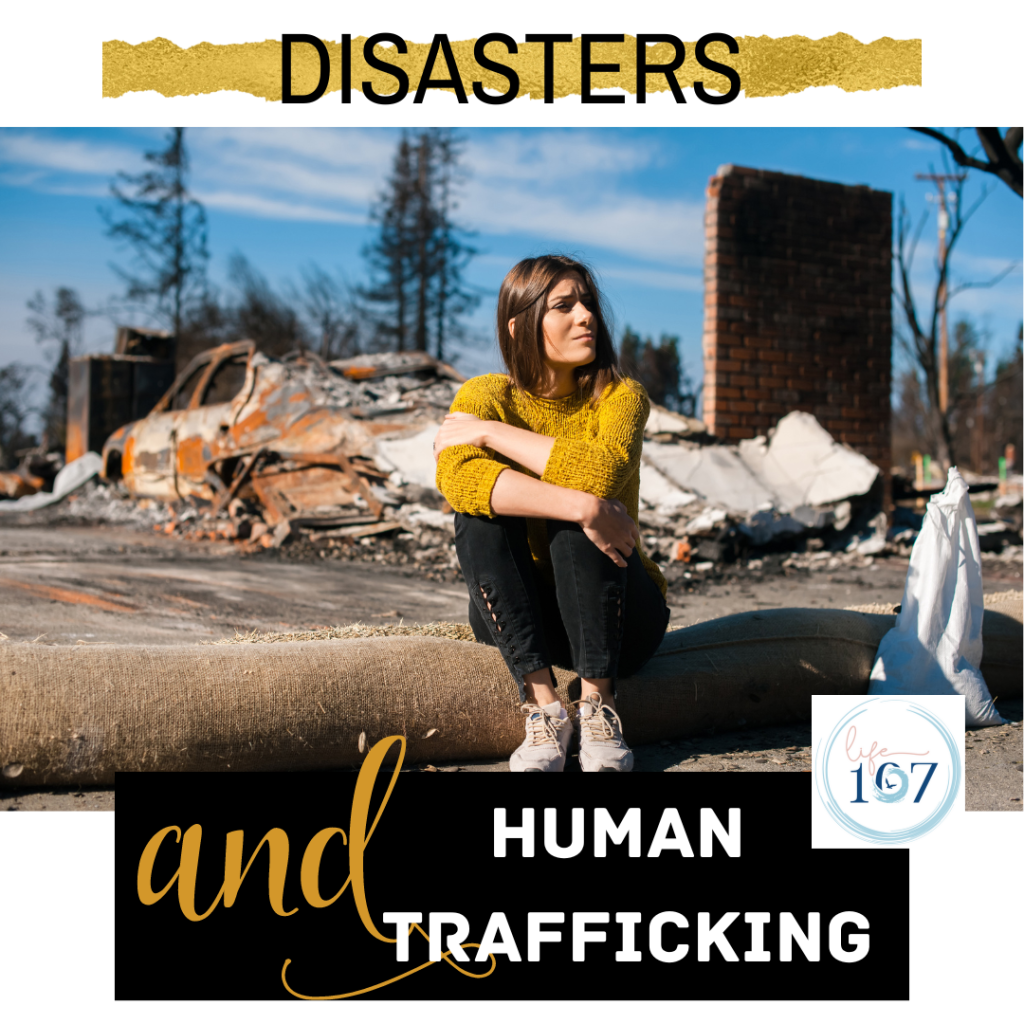
When a disaster strikes a community, it exposes preexisting vulnerabilities such as poorly built homes or weak infrastructure. An often-forgotten reality is that disasters expose a community’s vulnerabilities to human trafficking. If a community is vulnerable to human trafficking pre-disaster, the disaster only exacerbates that vulnerability. Discussing his experience during humanitarian crises, Dr. Jamie Aten (n.d.), a disaster expert at the Humanitarian & Disaster Institute, reported, “women and young girls are particularly at threat for experiencing a wide range of atrocities and traumas.” Therefore, knowing children, especially small children, are vulnerable in times of peace; in a large-scale emergency, they are incredibly vulnerable. A disaster or mass trauma can expose women and children to harmful conditions that are either a direct result of the disaster, by other disaster survivors with malicious intent, or by predators seeking victims to traffic.
For example, the crisis in Ukraine is a man-made disaster and complex emergency in terms of populations in need of aid. That is to say, first, it is complex because soldiers are wounded and dying on both sides of the conflict. Next, Ukrainian citizens are in the line of fire and suffering from the attacks. Finally, simultaneously, refugees seek asylum across borders, and IDPs (Internally Displaced Persons) travel inside Ukraine’s borders to avoid the dangers of battles. Because of these factors, the most vulnerable populations in Ukraine are women and children. Fear surrounding the complexities of war, forced migration, and the anxiety from looming threats, contribute to their experience of complex trauma. The connecting point for disasters and traffickers is the increased opportunity for manipulation of those experiencing these vulnerabilities. Disasters offer traffickers the advantage because they “offer jobs, shelter, transportation or to fill any of the other massive and multiplying unmet needs of individuals and families facing increasing desperation.” (Essential Resources for People Affected by Conflict in Ukraine and Afghanistan | Polaris, n.d.). Indeed, women and children in Ukraine are exposed as easy prey for traffickers as they seek refuge or during their plights to flee violence.
With this in mind, it is better to safely prepare a ship for a storm at the harbor rather than repair the ship during the climax of a storm. Unfortunately, communities are often oblivious to those vulnerable to human trafficking in the wake of disasters, especially if the disaster has affected us personally. Nonetheless, if we work to reduce or eliminate vulnerabilities to human trafficking before a disaster strikes, we protect women and children from falling victim to sex traffickers post-disaster.
Accordingly, disaster relief organizations classify the reduction of vulnerabilities to disasters as “mitigation/prevention” under the pre-disaster phase of the Disaster Management Cycle. The anti-human trafficking sector would agree that their programs on prevention work to build capacities in the communities they operate.
Put simply, it is not required for community members to be disaster experts if we want to protect our vulnerable populations from the threat of traffickers during disasters. Accelerating our community efforts toward the prevention of human trafficking will invariably mitigate the threat of predators during a humanitarian crisis.
Are you passionate about building the capacity of your community and other communities to stand impervious to human trafficking in times of peace or crisis?
Here are a few actions you can take:
- Educate women and children about traffickers’ tactics and recruiting methods
- Bring awareness to all the complexities of human trafficking by posting warnings on your social media networks
- Advocate for our governments to establish safe spaces for women and children to shelter in preparation for the next disaster
- Post the National Human Trafficking Hotline number up in storm shelters and homeless shelters
- Reduce the demand for trafficking victims by fighting the porn industry
- Volunteer with local anti-human trafficking organizations
- Implement fundraisers and donate to programs focused on preventing sex trafficking
To learn more about how you can help reduce the vulnerability of communities to threats of human trafficking, contact the team at Life 107.
References
Aten, J. (n.d.). Women & Girls Friendly Space Program. Wheaton College. https://lms.wheaton.edu/course/5422225561/materials?f=535882621
Essential Resources for People Affected by Conflict in Ukraine and Afghanistan | Polaris. (n.d.). Retrieved June 11, 2022, from https://polarisproject.org/blog/2022/03/essential-resources-for-people-affected-by-conflict-in-ukraine-and-afghanistan/
An Unlikely Trio
By Demetria Gilliam-Williams
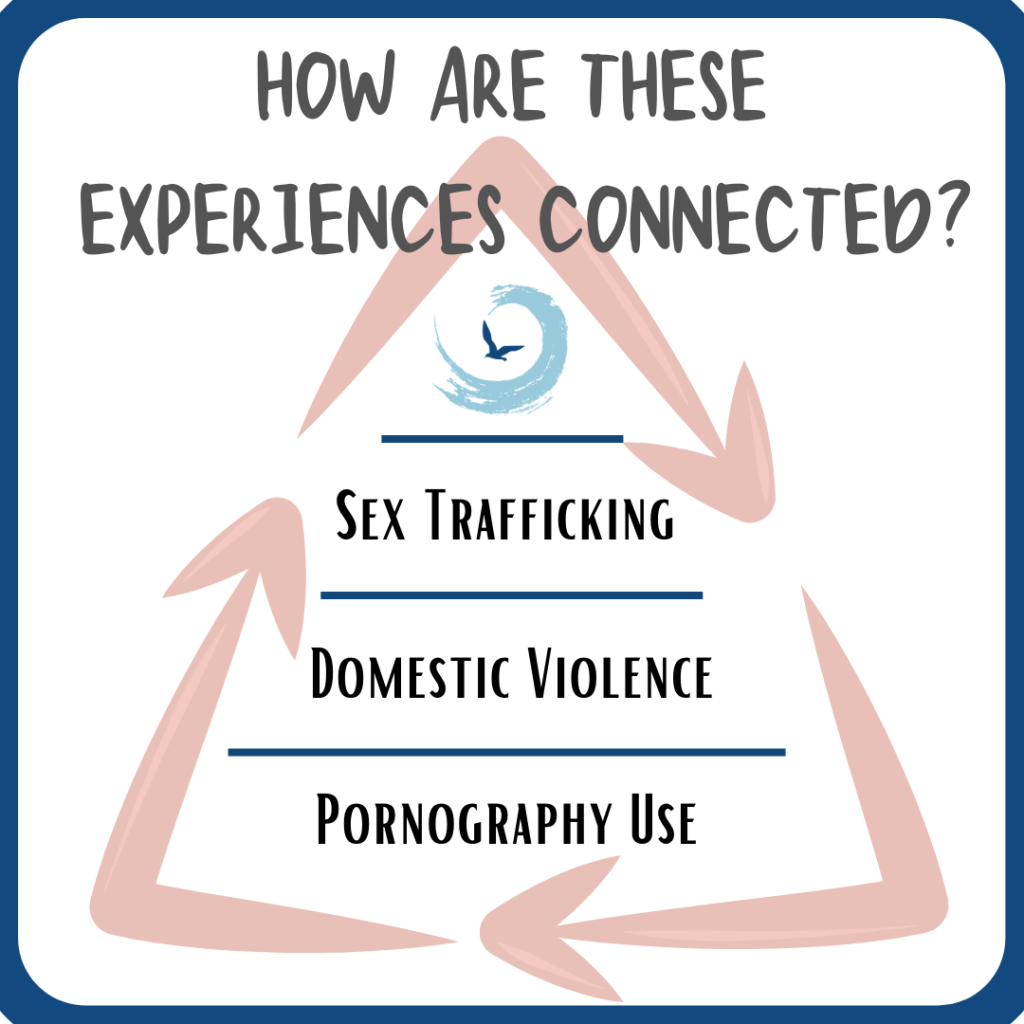
At first glance, domestic violence and trafficking seem to stand at a distance from one another. But when we dig deeper into the logistics of traffickers and violent intimate partners, we see an unmistakable connection. The National Network to End Domestic Violence (NNEDV) highlights this intersection — “There is a marked overlap in the pattern of behaviors that both abusers and traffickers use to exert power and control over a victim.” Trafficking and intimate partner/domestic violence are often interconnected. This is clearly seen in the similarities among perpetrators, their tactics, and the trauma endured by victims.
One of the most common forms of trafficking occurs within an intimate partner or marital relationship. Therefore, many victims of trafficking within this context, who are also abused in other ways by their partner, may not identify as a trafficking victim. Many victims who are trafficked in an intimate partnership relationship do not realize the exploitative component of their abuse as a distinct form of victimization.
Whether a perpetrator is abusing a partner physically, emotionally, or sexually, they are abusing with similar tactics and from the same motivation – the need for control and power (NNEDV). Those who abuse partners or exchange their partner’s sex acts for profit are engaging in similar tactics for compliancy that include threats, mental and physical abuse, starvation, isolation, and rape/sexual assault.
A further but accurate stretch of connection, is the interplay between domestic violence, trafficking, and pornography – making this an unlikely trio. How is the use of pornography related to abuse in relationships and trafficking? Of the many effects of porn use, porn is a major contributor to violence in relationships. The National Center on Sexual Exploitation make the intersection between pornography and perpetration with the ultimate conclusion that because porn normalizes violence and sexual degradation, those who view porn are more likely abuse an intimate partner (NCOSE).
Individuals in abusive relationships can also be threatened with sextortion or revenge porn. Revenge porn occurs when images or videos of sexual encounters are recorded and the victim is threatened with the release of those images/videos (NCOSE). Perpetrators can use these tactics to keep partners silent and submissive in an abusive situation (NCOSE).
When dissecting the crossover between three experiences, domestic violence, human trafficking, and porn use, we can also see similar effects to victims. All victims exposed to these types of abuse are affected in some form and experience long term impact on mind, body, and spirit.
There is no room for domestic violence, sex trafficking, and porn use in a healthy, thriving community. You can stop the cycle of violence and help victims who are experiencing abuse and exploitation.
- If you know a child who is being exposed to domestic violence, call Law Enforcement or DSS.
- If you are experiencing domestic violence, reach out to the National Domestic Violence Hotline: 1-800-799-7233
- If you know someone who is experiencing domestic violence, reach out to them and offer to help make a path out of the situation.
- If you suspect a person is being trafficked or sexually exploited, offer help or give a tip at the National Human Trafficking Hotline : 888-373-7888
Works Cited:
The National Network to End Domestic Violence (NNEDV)
- https://www.acf.hhs.gov/fysb/news/domestic-violence-and-human-trafficking-advocacy-intersections
- https://nnedv.org/latest_update/intersections-domestic-violence-human-trafficking/
The National Center On Sexual Exploitation
- https://endsexualexploitation.org/articles/three-ways-domestic-violence-is-connected-to-pornography/
The Good Shepherd Never Forsakes the Bummer Lambs
By: Maureen Hager @ www.MaureenHager.com
Author of: Love’s Bullet
Scriptures have a lot to say about sheep. I love all the Bible references referring to the sheep and the shepherd. The Good Shepherd will never forsake His flock of believers. The only color God assigns His sheep is crimson red. “Come now, and let us reason together,” Says the Lord, “Though your sins are like scarlet, They shall be as white as snow; Though they are red like crimson, They shall be as wool.” Isaiah 1:18 (NKJV)
White Sheep – How many images have we seen where cute, cuddly, woolly creatures joyfully follow the shepherd? While this may bring a smile to your face, I know the reality is that sheep are stubborn and intent on their own way. Does this sound like anyone you know?
Too often, we leap and follow our own plan, or we follow others. The white sheep must depend on the Shepherd to hear His voice and be led by His Spirit.
Black Sheep – We’ve heard the expression, the black sheep of the family. What a miserable label to have pinned on yourself. Have you shamed or embarrassed the family because you have strayed from their standards? Perhaps, your heart is rebellious, and you have disappointed the ones you love, including yourself.
The black sheep must depend on the shepherd to live the abundant life the Savior has bought for them. Every one of us, at one time or another, has been lost. The shepherd searches for his lost sheep and extends his arms wide open in welcoming him home with unconditional love. “I say to you that likewise there will be more joy in heaven over one sinner who repents than over ninety-nine just persons who need no repentance.” Luke 15:7 (NKJV)
Bummer Lambs – Occasionally, ewes will give birth to a lamb and then reject it. An orphan lamb cannot be raised by its mother and needs to be fed on a milk replacer. At times the ewe may reject the lamb simply because it cannot produce enough milk. Other times the mother refuses to care for her young. These rejected and abandoned lambs can be seen hanging their heads low – their spirit is broken.
The orphan lambs must depend on the shepherd to live. He nurtures the lambs just like a mother ewe. Without Him, the lambs would die. When the lamb is strong enough, the shepherd returns it to the flock. As a result, when the shepherd calls to the flock, the bummer lambs run to him first. They have received the blessing of having been personally cared for by the shepherd. “My sheep hear My voice, and I know them, and they follow Me.” John 10:27 (NKJV)
You may be broken and rejected today. You may feel like a bummer lamb. Rejoice! The Good Shepherd will hold you in His arms and hold you close. Listen to His heartbeat and rest there until you are healed and become whole again.
Brokenness is a gift from the Good Shepherd. Those of us who know we are broken and loved by God eagerly run to Him for His grace, His mercy, and His goodness. What a blessing!
You may be broken and rejected today. You may feel like a bummer lamb, but there is good news for you. The Good Shepherd will gather you in His arms and hold you close so you can hear his heartbeat. And you can rest there until you are healed and whole again.
~ Maureen Hager is the author of “Love’s Bullet,” inspiring speaker, and a Life 107 Mentor.
Every 10 Seconds
by Laura-Beth Rimmer, Life 107 Board Member
April 22, 2021
There are many “hot” topics today, one being sex trafficking. But like so many of these arenas we can quickly get lost in the facts and statistics and forget that each one of these pieces of information represents an individual who has been exploited.
Exploitation comes in many forms and when it comes to sex trafficking some of those who are worst off are children. April is National Child Abuse Awareness Month and with abuse at a high, it makes sense to highlight this issue right now. Every 10 seconds a report is made about child abuse in the United States (according to Child Help).
Every 10 seconds.
Many of those who are trafficked will tell you that it all began with abuse, and often it was inflicted by someone who was seen as “trustworthy”, whether that be a guardian, a family member, or a friend’s parent. So let’s talk about one of the roots of trafficking: child abuse. You see there are many children living in homes of instability, where they walk on egg shells not knowing what sort of reaction they might receive for doing well in school, not being home on time, or for doing something “out of the ordinary.” They might also be in a position where they consistently anticipate a sexual act or a violent response, hence staying silent and not letting anyone in on their home life.
If we continue on the thread of things being unstable another aspect to look at is the foster care system and how many times it sets kids up for failure. There are many incredible foster parents who love tirelessly on children who came from backgrounds of hopelessness. However, there are many children within the system who have had horrific experiences both through temporary housing situations or from their families. Blood family many times wins the foster care cases in the court system, and while there has to be something like this in place, the amount of children that are placed in homes that are less than satisfactory is astronomical.
Teachers, nurses, and flight attendants are some of those on the front lines to notice that abuse and/or child trafficking is going on. But what if we trained children on the signs to look out for? Children have one of the greatest avenues of reporting what is happening, because they are a child. We’re scared of telling children too much because we don’t want them to be afraid, but we all have children present in our lives and have opportunities to teach them. Instead of viewing it as children becoming fearful and living on edge, what if it actually made them more courageous, because you told them how lives are being preserved and that they can be a part of the solution.
Sometimes the simplest actions can be the very things that create the biggest impact. You hear stories of people who were going to commit suicide but someone simply stopped and took time to smile or talk with them and it completely changed the outcome. Let’s help make the newest generation aware and vocal about abuse. Silence is the enemy.
Things to teach your child:
- Encourage them to befriend the lonely child at school
- To be aware of bruises on their friends and to ask how they got them
- Trusting their gut, if they feel that something is off, it probably is
- To not keep secrets. According to a therapist: “privacy is good but secrecy is not”. If they hear about a parent/guardian hitting someone, or emotionally/sexually being abusive to come have a conversation with you or their teacher.
For the rest of this month (and continued on) may we focus our time, attention, and prayers to the children in our nation who are in a pit of hopelessness, struggling to make sense of the trauma they are dealing with, and feeling that this is all there is to their life. Use the wisdom and position that you have to show children that abuse will not be tolerated and that you hold them in high regard. Who knows if a child’s future will be altered because you weren’t afraid to share the truth?
~ Laura-Beth Rimmer
Check out this simple infographic below, by NCJTC to understand child abuse in America.
Safeguarding Virtual Classroom Kids from Sexual Exploitation: Tips for Teachers
March 30, 2020
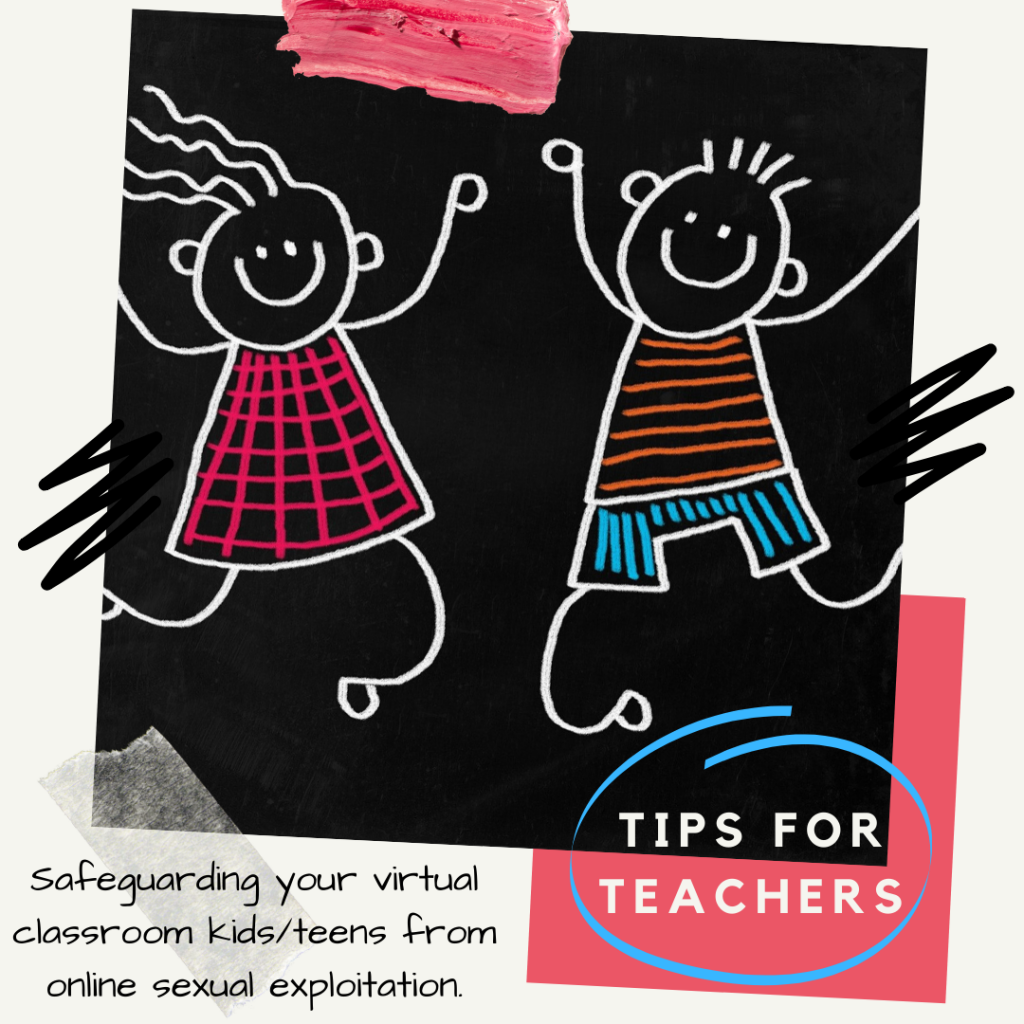
As children are relocated from classrooms to homes across the U.S., many organizations are discussing the stark reality that online predators are taking note (NCOSE endsexualexploitation.org). It is overwhelming to consider the present danger to children and youth in our nation, state, and our hometowns. The good news is that teachers are on the frontlines of protecting their students even through virtual classrooms!
If you are a teacher, you are likely preparing digital materials to stay connected with your students and you may have concerns for their wellbeing while away from school. Thank you for being who you are to your classroom kids/teens. Your trusting relationship with children could be the relationship that gets them through a difficult time; and this may be that time. You are in a privileged position for influence as you encourage them and reinforce positive behaviors while they are at home – including protection against online predators and sexual exploitation.
Both girls and boys (young ladies and young men) are at risk for exploitation and as they utilize digital devices with more time in hand, there will be an uptick in online solicitation (NCOSE). Girls are most at risk for grooming and sextortion. Grooming occurs when a predator or trafficker coerces victims into an exploitative situation through flattery, manipulation, and/or lies. Sextortion occurs when a predator obtains pictures of a minor and holds those pictures for ransom and threatens to expose them (Thorn.org). The victim is then forced to either send more pictures or commit sex acts. Half of all sextortion takes place on social media outlets (Thorn).
Boys are most at risk for being exploited by exposure to pornographic material. Children are exposed to online images of sex acts (pornography) at an alarming rate, whether intentional, unintentional, or peer shared. We also know these exposures are happening at an early age – some research shows an average age of 11 for first exposure (endsexualeploitation.org). The evidence is undeniable that internet images of porn are destructive and addictive for any gender or age. Girls, boys, and teens are all at risk for exploitation, sextortion, and pornographic exposure!
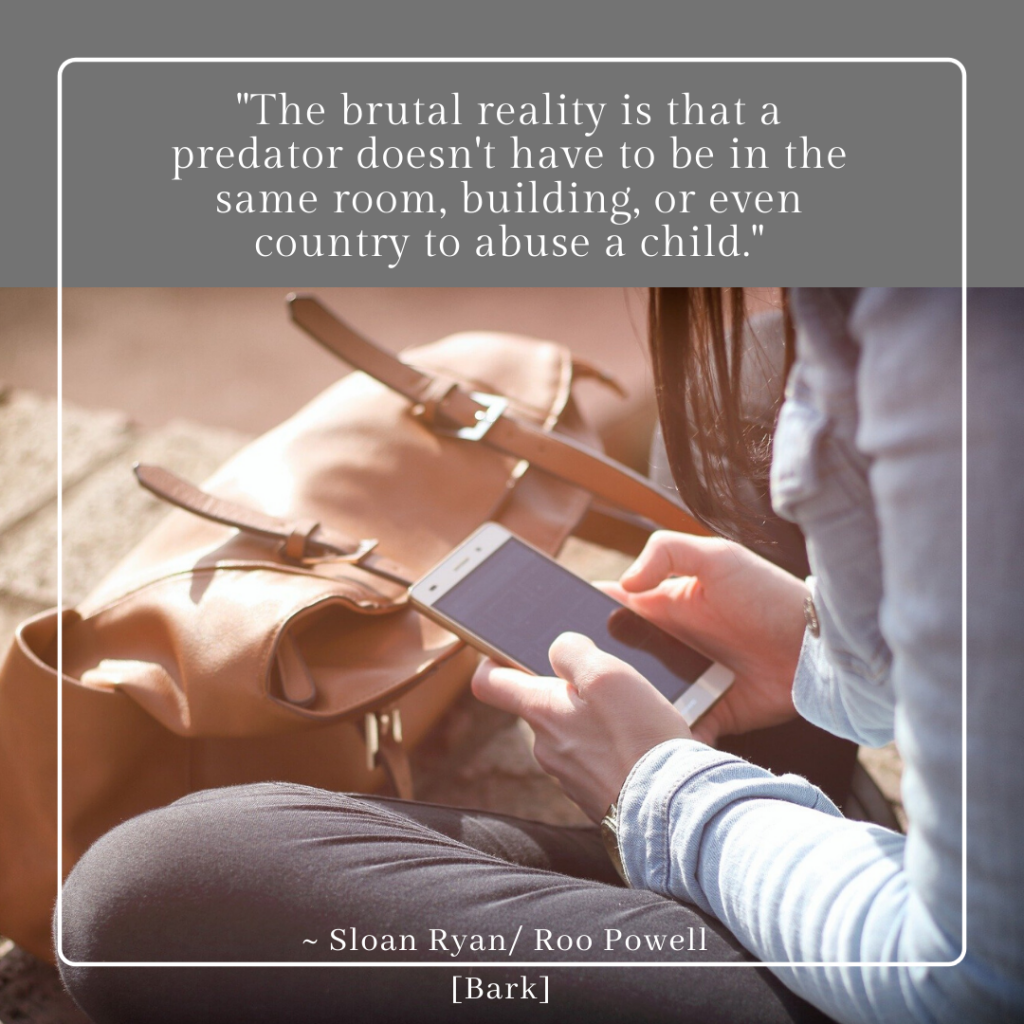
Bottom line – these interactions are a major threat to the innocence and wellbeing of precious lives. Thankfully, you can protect your students by reminding them of online safety. Below are some tips as you remain one of the most influential adults in their lives.
Encourage your classroom kids and teens to:
- Only research online or view material that they would feel comfortable viewing, with you (their teacher) sitting beside them.
- Avoid interacting with any new “friends” online. A friend is not an online profile picture of someone they don’t know well. Predators often manipulate children and teens with lies and flattery.
- Not send pictures of themselves to others – even to friends. These pictures can be used against them in threats and entrapment. If they already have, encourage them to tell a trusted adult. It’s important they know they will not be judged or punished.
- Never attempt meeting anyone they are connected with online.
- Avoid conversations on social media, texting, video apps, or online gaming systems with anyone they don’t personally know. “Personal” means a person they have had multiple face-face interactions with and has proven to be trustworthy.
- Trust their gut. When something doesn’t feel right, it isn’t. Be courageous and leave or exit any interaction or material that instigates a gut reaction.
- Always remember their immense value, worth, and promising futures and that you are always there for them.
Thank you for the commitment you show daily to your classroom kids/teens and for your presence during virtual learning. The Life 107 team supports you in this time of transition. If we can be of assistance, please email director@life107.org or visit us online at Life107.org.
Demetria Gilliam-Williams, MACM
Executive Director, Life 107
& The Life 107 Team
Sex Trafficking’s Response to COVID-19
March, 19, 2020
The trade of humans for sex has temporarily slowed as society hibernates under pressure of the recent pandemic, however the pain, destruction, and alienation of victims is still very much a reality.

In the past couple days concerns about society’s shutdown have provoked thought about this unprecedented response to disease and how it will affect the commercial sex trade – an industry with billions of dollars at stake. We would be amiss to assume the safety and wellbeing of victims, simply because they aren’t actively being sold to buyers at this brief point in time. So what happens now that the second most profitable illegal industry, is seemingly placed on hold?
It is said that victims of trafficking are sold (raped) on average 10 times a night (icmec.org). Sold to buyers acting upon the conditioning of their desires, often driven by pornography, to purchase these girls/boys and commit violent and dehumanizing acts of rape. But now, with the US on pause from going much of anywhere (especially to hotels and large gatherings) what is happening to these precious girls/boys who have been stripped of their humanity and turned into objects for sale?
When we think about the industry and its victims, we must recognize the mechanics of the illegal business. The system of trafficking is threaded with deceit, deception, danger, control, and suppression. The entire network and capacity of a pimp to sale their commodity is literally held together and dependent on a pimp’s skill and craft at keeping a victim so unattached from their own self-identity, that she/he adopts the pimp’s reality as her own (inferred, The White Umbrella). This business is knit by men and women who are willing to strip other humans of their freedom and identity to sale them for personal profit.
Most often, in US domestic minor sex trafficking, a pimp retains all (ALL) profits made by their victims. If the victims don’t return “home” with their quota – the set amount of income required per night – a pimp uses anything necessary to make sure she/he knows this is not tolerated. Beatings, rape, starvation, withholding of contraception for their next night out, or sending them back out to be sold again, will be induced until the victim HAS made the pimp’s quota. We are forced then, to recognize two realities:
- A pimp is the only benefactor of the income brought by the rape of a victim.
- A victim is the one who suffers most when profit from her/his quota isn’t made.
Reasoning would conclude that although trading humans for income has temporarily slowed, victims will still surely suffer. As objects, victims have made revenue an easy asset for a pimp; one which purchases his cars, his rent, and his necessities. If she isn’t being sold, there will be no income. What now for a victim whose pimp has no substance in which she was unrightfully held responsible for? She/he will bear the response of an angry, desperate, and deceitful master who will no less, place her needs at the bottom of the barrel.
If anyone eats, it won’t be her.
If anyone bathes, it won’t be her.
If anyone has basic needs met, it won’t be her.
And when anyone gets angry or loses control, she will take the blow.
As if not being cared for or fed isn’t enough, keeping a victim suppressed and seasoned to handle the industry’s hazards of continual violence and rape, will still be a pimp’s main objective. For a victim will not be allowed any sense of power or identity, which would risk a pimp losing his main source of income. And their commodity cannot be tendered or lightened to the heaviness of continual rape. Therefore, a pimp will do anything it takes to make sure she doesn’t forget what it means to be violated. Anything it takes to remind her she is dispensable, of no worth, and that she has no place to go. And we can bet that has become her truth. She is stuck in a place called “home,” with a man/woman who inflicts intense pain harm in order to keep her conditioned for the industry while it waits for her return.
Stuck with no other place to go, not even to an outcall where a john (buyer) will rape her for money, but at least pay her at the end of his abuse. As a survivor has once stated, she often would rather be pimped out to johns at night than go home to her pimp (Rebecca Bender). This is the reality for victims; those stuck in a dark place, while the world stands still for COVID-19.
But there is hope. We can actually do something as we are redirected from our daily routines and have a bit more time to offer.
- If you see a young lady/boy on the street or someone who seems to be suffering, buy them a meal or purchase their items while in line at a store! Help others in any way which you feel safe.
- Pray for victims/survivors as they hope daily for the next day to be better: PROTECTION, SAFETY, CLARITY, NOURISHMENT, HOPE.
- Pray for pimps and johns. That is hard to perceive, but if we pray for the heart change of the heart of the industry, we might get somewhere.
- Post the National Human Trafficking Hotline on all your social media accounts. Most trafficking victims are allowed to use social media outlets. You are welcome to use the image below for social media posts.

Thank you for taking the time to read these extremely difficult words. Words that are hard to absorb, but once heard, can illuminate a light in us to shine for those in darkness.
There is hope.
It’s you.


